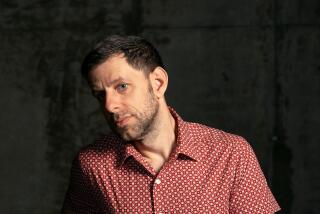From the Archives: Mehta Conducts First of Season’s Concerts; Director’s Debut Heralds Eventful New Chapter in Philharmonic History
- Share via
The Los Angeles Philharmonic Orchestra began a new and what promises to be an eventful chapter in its history when Zubin Mehta officially took over the reins as musical director and conductor at the opening concert of the 44th season in Philharmonic Auditorium Thursday night. Mehta becomes the seventh permanent conductor of the orchestra and at 26 the youngest ever to hold the position.
There was an agreeable air of suspense to the occasion, but also a happily discreet lack of pretentiousness. The subscribers were out in full force and there was the customary bustle and excitement of an important opening. But there was also a feeling of confidence for Mehta was no stranger to the public and they already know what can expected of him. The musicians stood to greet their new conductor on his modestly deliberate entrance, the audience applauded cordially, and after the national anthem everyone settled down to the serious business in hand.
Program Never Dull
But while serious, it was never dull. The program was wisely chosen not so much to exhibit the conductor as to provide a well balance fare of music touching on contrasting periods of musical history. Inevitably, of course, it did exhibit the conductor, and in the proper way, for it gave him scope to display his versatility in a variety of styles and in music of solid substance.
FULL COVERAGE: Inside the L.A. Philharmonic
The overture to Mozart’s “Don Giovanni” is not often excerpted as a concert piece, but Mehta proved without difficulty that it can stand on its own. Although he used the full string complement without fussily reducing it to traditional Mozartean proportions, it did not sound overblown. It emerged crisply, delicately, and with sharp rhythmic precision. Mozart in the restrained Viennese manner.
Contemporary Idiom
The contemporary idiom has its innings in the three excepts from Hindemith’s “Mathis der Maler” that used to be known as a suite but which now seems to have been advanced to the title of symphony. The nomenclature, of course, made no difference, for the work is one of the most durable examples of 20th century music and Mehta made it not only eloquent but let it serve as a fine demonstration of his ability to project and define a score strongly dependent on mood and color.
There was unquestionable mastery in the manner in which he illuminated the archaic, mystical feeling of the music and limned all the subtle instrumental combinations. He not only understood the meaning, he also extracted some splendidly vivid playing from the orchestra, and the final imposing climax brought forth a strongly enthusiastic audience reaction in which the conductor repeatedly shared bows with his players.
It was less of a surprise to find that a conductor of Mehta’s generation should expound Hindemith effectively than it was to discover him so genial to the romantic expansiveness of Dvorak’s Symphony No. 7, Opus 70, in D Minor; a work that has appeared only once previously on Philharmonic programs as Symphony No. 2, an earlier order of enumeration before it became know how many symphonies Dvorak actually had written.
Pleasurable Music
This may not be the greatest of Dvorak’s symphonies or a peak in the romantic literature but it is a highly pleasurable piece of music. It proved definitely that Mehta has the warmth and the feeling for such music that is so distinctly lacking in other young conductors.
He handled the rich melodic material affectionately and with splendid flexibility; he was as much as ease in this idiom as he had been in Mozart and Hindemith, and in addition he evidenced the sense of form which can hold a long and rambling work together with unity and proportion. The orchestral sound was rich, the details were aptly revealed, and like the other works on the program it was conducted from memory with unobtrusive authority.
The whole program was an auspicious beginning to Mehta’s regime, and at the conclusion of the symphony the public gave him and the players a cheering ovation.
More to Read
The biggest entertainment stories
Get our big stories about Hollywood, film, television, music, arts, culture and more right in your inbox as soon as they publish.
You may occasionally receive promotional content from the Los Angeles Times.










